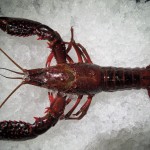- Crayfish are ideal organisms to use when teaching students in a laboratory
- They are invertebrate crustaceans, so there are no IACUC (Institutional Animal Care and Use Committee) regulations for experimenting with the animals
- They are inexpensive (Welsh and Smith, 1960; Welsh, Smith, and Kammer, 1968; Deyrup-Olsen and Linder, 1991; Parfitt, 2002; Hauptman and Curtis, 2009; Wyttenbach, Johnson, and Hoy, 2014; Johnson, Wyttenbach, and Hoy, 2014)

- They have relatively simple nervous systems and can remain physiologically active in vitro (Wiersma, 1958; Wiersma and Hughes, 1961; Wiersma and Yamaguchi, 1966; Kondah and Hisada, 1986)
- The anatomy of a crayfish can be learned quickly
- Crayfish can be used to learn about neurophysiology
- Light responsive optic nerve fibers
- Belong to a subset of diverse interneurons, located in the eyestalk of the crayfish (Meyer-Rochow, 2001).
- These interneurons integrate image-forming light signals that are received by the animal’s compound eye
- Belong to a subset of diverse interneurons, located in the eyestalk of the crayfish (Meyer-Rochow, 2001).
- Caudal Photoreceptors
- Not associated with image forming light responses
- Are believed to contribute other light-evoking behaviors, (circadian rhythms, backward walking, etc.) (Kennedy, 1963; Rodríguez-Sosa, Calderón-Rosete, and Flores, 2008; Edwards, 1984; Pei, Wilkens, and Moss, 1996).
- The 2 cell bodies that comprise the caudal photoreceptor are located in the 6th abdominal ganglion, where they send signals from their axons to the brain, via the ventral nerve cord (Kennedy, 1963; Wilkens and Larimer, 1972, 1976)
- The dendrites of the caudal photoreceptors are characterized as the light-sensitive portions of the neurons. They project to the contralateral side of the abdominal ganglion
Objective/Purpose
- To describe methods that use crayfish in order to teach students how to extracellularly record spike activities of light responses from two types of visual interneurons: optic nerve fibers and the caudal receptor
- More specifically, dissections and recording procedures will be documented that provide students with a comparison of the light responses from different photosensitive, (light sensitive), neurons found in the caudal and rostral ends of the crayfish
- Few exercises have been developed that focus on light-driven neural processes, so these methods will provide an unique comparison
